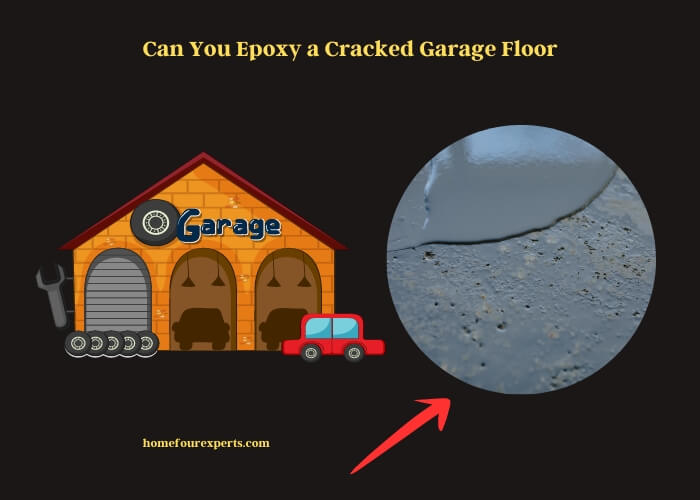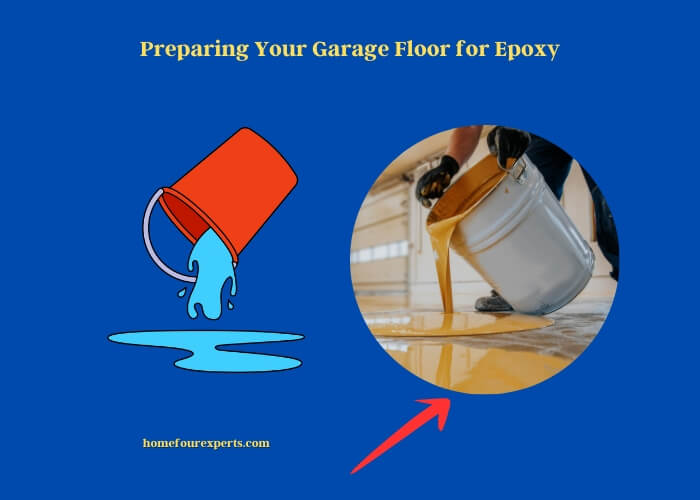Can you epoxy a cracked garage floor? Absolutely, you can! But, it’s not just about slapping on some epoxy and calling it a day.
Preparation is the starting point. The cleaner and smoother your surface, the better the results. If you’ve got cracks, their width is vital to consider. Smaller cracks might fill in with the epoxy itself, while wider ones need patching up first. Ensuring the garage floor is free of moisture is critical. Any dampness can mess with the adhesion of the epoxy, leading to peeling or bubbling later on.

Choosing the right epoxy type for your garage makes a big difference. Some are more suited for heavy-duty use, while others may prioritize aesthetic appeal. As you apply, be mindful of the temperature. It can influence curing time, and if it’s too cold or too hot, your epoxy might not set right. Oh, and don’t forget about thickness. A consistent layer contributes to the durability of the floor.
Sounds simple enough, right? But there’s more to it than meets the eye. If you’re looking to make your garage floor shine and last for years, make sure to fix those cracks before going in with the epoxy. Trust us, a bit of extra effort now will pay off in the long run.
Curious about the nitty-gritty details? Dive deeper with the detailed article below. You won’t regret it!
Can You Epoxy a Cracked Garage Floor?
Let’s imagine your garage floor as the skin on your face. Just as you’d care for your skin to prevent and treat blemishes, your garage floor requires the same love. Sure, a crack here or there might seem harmless, but let’s dive into why taking care of these imperfections with epoxy is more than just a cosmetic choice.
The Importance of Garage Floor Maintenance
Think of your garage as the shield for your beloved car or workshop. Keeping it in prime condition isn’t just about showing off to neighbors; it’s about safeguarding your investments inside the garage. A well-maintained floor can prevent slips, keep pests at bay, and just makes the space look neat.
Why Cracks Appear on Garage Floors
Ever wondered why those annoying cracks appear? They’re not just a sign of aging. From temperature shifts playing tug-of-war with your floor to your heavy SUV putting pressure, there are many culprits. Not to mention, water is a sneaky villain. If it seeps in and freezes, it can widen those cracks even further.
Choosing Your Epoxy: Types and Their Benefits
Ever felt overwhelmed with all the epoxy choices out there?
| Epoxy Type | Pros | Cons | Best For |
| Water-Based | Environmentally friendly, easy cleanup | Less durable | Light traffic areas |
| Solvent-Based | Strong, resistant to chemicals | Harsh fumes, harder to apply | Workshops or areas with chemical spills |
| 100% Solid | Most durable, high gloss | Pricier, professional application often recommended | Heavy-duty garages |
Crack Assessment and Pre-Treatment
It’s not enough to say, “I’ve got cracks.” Let’s be more specific. The size matters. Some are like hairline fractures, while others might remind you of the Grand Canyon.
| Crack Width | Treatment Suggestion |
| Hairline (less than 1/16 inch) | Epoxy filler |
| 1/16 inch to 1/4 inch | Concrete patching compound |
| More than 1/4 inch | Seek professional advice |
Preparing Your Garage Floor for Epoxy
Prep time! No, not for a meal, but for your garage. A dirty floor is epoxy’s enemy. That oil stain from last week’s project? Time to tackle it. And if you think your floor is clean but it’s been rained on recently, be cautious. Any trapped moisture can sabotage your epoxy’s success.

Patching: Repair Before You Resin!
Rolling up your sleeves and getting to work on those cracks? Perfect. After all, epoxy isn’t a magic eraser, but it’s pretty close when used right.
| Crack Type | Patching Compound |
| Hairline | Epoxy filler |
| Wider Cracks | Concrete & masonry bonding primer |
The Art of Epoxy Application
Like painting a masterpiece, applying epoxy requires patience. If the surface isn’t sticky enough, your epoxy won’t cling. And remember the weather? A hot summer day or a chilly winter afternoon can influence how your epoxy sets.
Epoxy Curing: What to Expect
Tick-tock, tick-tock! Waiting can be the hardest part, but it’s crucial. Let your epoxy sit and cure. Walk on it too soon, and you might leave marks or, worse, peel up your new layer.
Enhancing Durability: Post-Epoxy Care
Once the epoxy is down, your job isn’t over. It’s essential to keep your garage floor looking its best. Avoid dragging heavy machinery or tools across the surface. Do regular sweeps to remove dust and debris. For spills, especially oils or chemicals, a quick cleanup can prevent stains. Remember, epoxy is tough, but with a bit of care, you can ensure it stays glossy and crack-free for years.
Common Mistakes and How to Avoid Them
There’s no shame in making mistakes; they’re our best teachers, right? But when it comes to epoxy, some missteps can be costly. Here are a few pitfalls to watch for:
- Skipping the Prep Work: Think of epoxy like a cake. Would you bake without prepping your ingredients first? Ensure the surface is clean and moisture-free.
- Ignoring Manufacturer’s Instructions: Every epoxy type is unique. It’s tempting to think you know best, but those guidelines are there for a reason. Stick to them.
- Uneven Application: Imagine wearing one high heel and one flat shoe. Uneven, right? The same goes for epoxy. Keep your layers even for the best results.
Benefits of Hiring Professionals vs. DIY
If the thought of epoxying your garage floor has you sweating bullets, it might be time to call in the pros. They’ll have the tools, knowledge, and experience to ensure a flawless finish. On the other hand, if you’re eager to put in some elbow grease and love DIY projects, go for it! Just arm yourself with knowledge, take your time, and remember: preparation is key.
Summary
Your garage floor works hard. It’s where you park your car, do your DIY projects, and store countless items. So, it deserves some TLC. Whether it’s a tiny crack or a gaping hole, with the right epoxy solution, you can make your garage floor look brand-new. Plus, now that you’re equipped with the how-to, you can tackle those cracks with confidence. So, what are you waiting for? Give your garage the facelift it deserves!
FAQs: Epoxying a Cracked Garage Floor
What Are the Disadvantages of Epoxy Flooring?
Epoxy flooring, while durable and versatile, can sometimes become slippery when wet. It’s also sensitive to UV rays, which can cause color changes over time. Additionally, improper installation can lead to bubbles or peeling.
How Can You Fix Concrete Cracks in a Garage Floor?
Start by cleaning the crack and surrounding area. Next, use a concrete patch or filler, ensuring it’s pressed well into the crack. Once dry, sand it down for a smooth finish. It’s now ready for epoxy or other treatments.
Are There Pros and Cons of Epoxy Garage Floors?
Absolutely! Pros include durability, resistance to stains, and a sleek appearance. Cons might include potential slipperiness when wet, UV sensitivity leading to color changes, and the need for professional installation to avoid errors.
Can You Apply Epoxy Over Cracked Concrete?
Yes, but it’s essential first to repair significant cracks to ensure a smooth, lasting finish. Small, hairline cracks might get filled with the epoxy itself, but larger cracks should be addressed separately.
How Should You Fix Cracks in a Garage Floor Before Applying Epoxy?
Clean the area thoroughly, remove any loose debris, and then use a high-quality concrete patch or filler. Ensure the filled area is level with the rest of the floor. Once it’s dry, you can sand it smooth and proceed with the epoxy application.
Does Epoxy Flooring Crack Over Time?
While epoxy itself is quite durable, it’s only as good as the surface it adheres to. If the underlying concrete shifts or cracks, the epoxy layer might also crack. Proper surface preparation can minimize this risk.
Why Would an Epoxy Floor Crack?
Epoxy floors might crack due to several reasons: improper preparation of the underlying surface, extreme temperature fluctuations, or issues with the concrete foundation. Sometimes, heavy impact or sharp objects can also lead to cracks.
You might also enjoy:
- Can I Store My Christmas Decorations in the Garage?
- What Size is a Golf Cart Garage Door? (Answered with Well Explanation)
- Why Are There Flies in My Garage? (Here is the Reason)
- How to Hide Garage Walls for Party? (Here is the Process)
- Does Paint Freeze in Garage? (How Long Does It Take)
- The Ideal Battery Size for Your 50hp Johnson Outboard
About This Writer

Hi, I am Eric Devin and I am a professional interior architect. Since childhood, I've always enjoyed DIY projects! And, I have loved to solve simple household problems using essential tools and equipment. I have also acquired a lot of information about basic household tools settings by working with contractors.